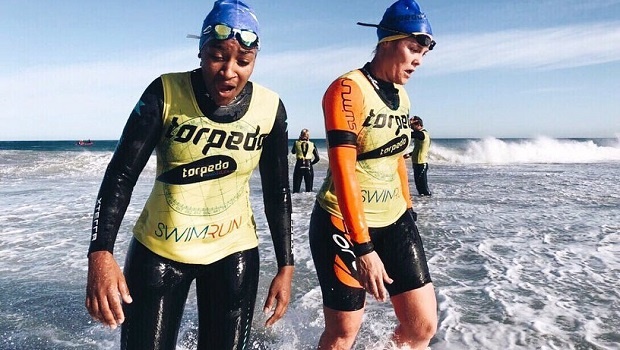
Hands up if you only exercise for that #summerbody? I did too. Until Torpedo SwimRun, where I found myself focusing on an entirely new goal: conquering the ocean.
When I started writing for Women’s Health, I realised exercise had a ton of other things going for it: the mental health perks, the general good-for-you status. But what I hadn’t done, not really, is use exercise as training for a specific event.
I’m a lifeguard and surfer (mainly as an excuse to be at the beach as regularly as possible) and when Torpedo contacted me about doing the Cape SwimRun, I thought about it seriously, then said yes.
READ MORE: These swimming hacks will make you less afraid of the water
Torpedo is popular with lifeguards for obvious reasons and I figured I’d be ok. The race route is also absolutely stunning: there are panoramic views of the 12 Apostles and endless stretches of the Atlantic to run along and swim in.
I also had the chance to explore tiny beaches and enclaves in Cape Town that I wouldn’t ordinarily have traversed. And not just look at the view, but really go into the water, weave through the kelp forests, relish in the crystal-clear waters.
It was magical.
Another bonus of the relatively new sport is that it’s way less equipment-heavy, making it more accessible. No pricey bikes, helmets or other tech.
All you need is a wetsuit to protect you from the icy Atlantic (we used a really great one from Xterra) and running shoes (Pro tip: in the race, you swim in these, too, so get a pair that’s light but supportive on the ankle).
The training
I enlisted the help of a physiologist friend, Tayla Faulmann, who became my race partner. She also devised our training programme. On the schedule: regular swims in the pool combined with long runs to get us used to the 16km of running and swimming that the race demanded.
We also tossed in weight training sessions to build powerful muscle and an open-water swim.
With less than three months until the big race, we had a ton of work to do. Every second day was cardio training, either in the pool or by running a minimum of 6km. Most of the time, the runs were 10km, especially in the month leading up the race.
Tayla and I teamed up and did our swim training sessions together. Most of the time, we focused on stroke correction for myself, along with tips on how to swim in open water. Pro tip: this involved doing intervals of fast and slow laps in the pool, and intervals of water polo-style swimming (head above water).
This had the dual purpose of engaging different muscle groups to make sure we could compete with choppy water while also improving speed.
READ MORE: Swim wetsuit tips for beginners
The race
At the race registration, we were given a whistle (to signal for help), a swimming cap and chaffing cream (a major key when your wetsuit is rubbing up and down your neck, giving you a rash). To help wash down my nerves, they also gave us a beer, and I’m eternally grateful for that.
Torpedo seemed like a no-brainer at a glance: you’re just swimming, then running, then swimming again, right? Not so.
There are rocky routes, and because exploration is sewn into the race’s DNA like the Gryffindor sigil on Harry’s robes, entry into and exit from the water is not for the faint-hearted.
The segment from Llandudno to the beach break, for example, involves jumping from the rocks into the blue below; then it’s a 900m swim towards Llandudno beach, where the shore breaks are famously savage. (If you don’t believe me, check the video below of a lifesaving competition at Llandudno beach.)
There’s a tour recce before the race to get a feel for the route, too, so you’re prepared for what’s to come.
During the race, I was dumped by several waves – the trick is to figure out how to navigate these. Pro tip: when approaching the beach, where waves can tumble you around until you’re not sure which way is up, it’s important to dive under them and let the wave pass over you.
In the end, the race I competed in happened upon the toughest conditions in the race’s history. Gale force winds made much of the ocean swims very challenging and at many times, I wanted to quit. But my partner Tayla kept encouraging me and pushed me to finish strong.
There was also a segment that offered much-needed refreshments at Bootlegger and during another segment, you could get your anti-chaffing cream topped up.
I’ve also never been so grateful for kelp. Pro tip: when the tide picks up and the wind blows, hold onto kelp to keep yourself from being pulled back by the water. I also ended up using it to pull myself closer to the shore.
This race taught me a lot about myself. I didn’t think of myself as a particularly brave person, but the fact that I bared my tiny body to 4km of open water makes me feel really strong.
I also have always thought of myself as a water baby but the ocean begged to differ. One does not simply dip their toes in Clifton once and call themselves a #saltysoul.
Myself and Tayla at the finish line. I’m eternally grateful she was there to help me through it.
This article was originally published on Women's Health.




 Publications
Publications
 Partners
Partners















